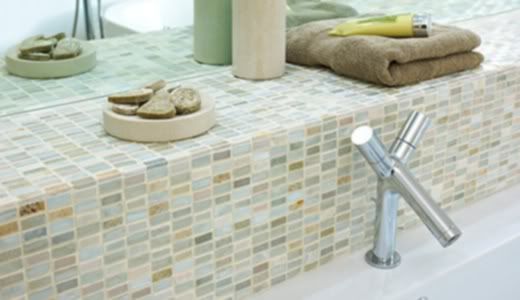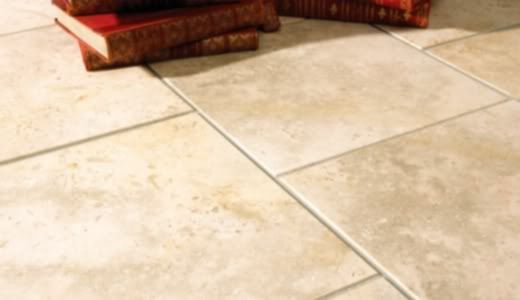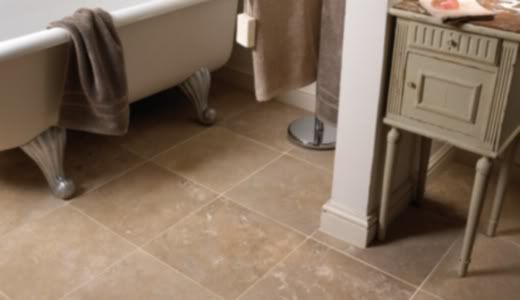Slate is an extremely versatile building material, Slate benefits from a number of practical properties
making it an exceptional building material. It retains its natural colour, even
in UV light and is impermeable to water. It is also extremely durable,
unaffected by normal extremes of temperature and highly resistant to chemicals.
It is also an attractive and popular decorative stone, here are the 8 top uses for natural Slate in the home.
 |
| A slate quarry face, its hard to imagine it as a tile in your kitchen. |
1. Slate Floor Tiles - Interior
Slate tiles are durable, non-slip and very hard wearing. This makes them a
great choice of floor tile, that can be used in wet or high traffic
areas. Slate floor tiles are often used in areas such as Kitchens,
Bathrooms, and Conservatories.
 |
| Black slate floor tiles in a kitchen - stunning! |
2. Slate Paving - Exterior
Because
of the natural non-slip surface of natural riven slate, and its ability
to withstand frost and poor weather without spoiling, it is also a very
sensible choice for exterior
slate paving. Patios look great in either
Brazilian, Chinese or Welsh Slate, and it can also be used on pathways
and pond/swimming pool sides.
 |
| Welsh slate paving with a natural riven finish - Gorgeous! |
3. Slate Wall Tiles or Cladding
Slate
wall tiles are often used in shower and wetrooms,
Slate wall tiles can
also be purchase as a strip length, which can be fixed as wall cladding.
If a suitable stone sealer product is used, then slate tiles can also
be used for a kitchen splashback.
 |
| Slate wall tiles cut into strip wall cladding. |
4. Slate Fireplace Hearth
Slate
slabs are available in small or large sizes, and can be fabricated to
fit as a fireplace hearth. As long as the recommended sizes are adhered
to, slate hearths are very hardwearing, and make a striking focal point
to any living room. Slate is also hard enough to use under a solid fuel
stove (such as a woodburner). The cost of buying thick slab slate can be
expensive, and so often it has been known for regular slate floor tiles
to be used to make a hearth, they would be fixed with cement to a stone
or concrete base.
 |
| Beautifully built fireplaces with Slate Hearths. |
5. Slate Kitchen Worktops
Slate
slabs are also used to fabricate worktops for kitchens or bars. Natural
slate has a cool and solid surface, and when it is smooth honed, it
bears similarities to dark Granite or Marble.
 |
| Slate worktops with a cutout for a traditional ceramic sink. |
6. Slate Window Sills
Slate
window sills are popular for their longevity and visual appeal. Natural
riven slate or sawn slate sills look fantastic in older properties, and
a straight cut slate window sill with smooth honed finish would fit
just as well into a modern setting. Slate window sills can be used both
indoors and outdoors. It is possible to have slate fabricated into
almost any size, and sills can have drip grooves cut into the underside
to guide any run-off water.
 |
| Slate window sill in a barn coversion property. |
7. Slate Walling and Coping
Slate
walling has been around for hundreds of years (pretty much as long as
slate has been extracted from the ground). It is possible to see
traditional slate walls made of either Welsh slate or Cornish Slate
(Delabole slate) that are over 300 years old. That is an example of
their strenth and vigour to the forces of nature. Slate walls look very
attractive when built in your garden, Slate wall coping is also a well
celebrated wall building material.
 |
| Slate walling as seen in rural Wales UK |
8. Slate Roof Tiles
Slate
roofing tiles are the ultimate test for this very hardy natural stone.
It is possible to see slate roof with the same tiles intact that are
well over 400-500 years old. Slate natural waterproof properties, and
its ability to be split into flat tiles made it the obvious choice for
making roofs from day 1.
 |
| Very old slate roof tiles |











 Actually, it could be worse than that, you could have paid a skilled professional builder or tiler to do the job, and upon inspection of the completed job, it becomes evident that you may have employed a cowboy builder.
Actually, it could be worse than that, you could have paid a skilled professional builder or tiler to do the job, and upon inspection of the completed job, it becomes evident that you may have employed a cowboy builder.











